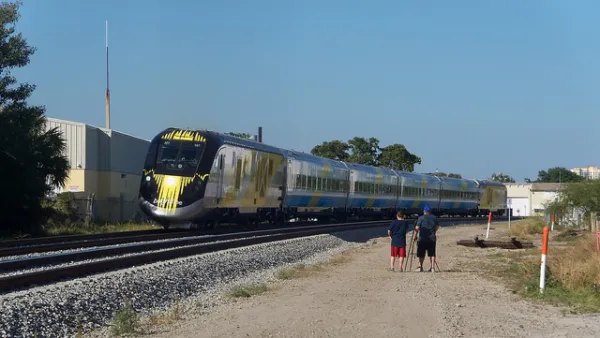The Florida Development Finance Commission voted 3-0 at a contentious meeting to approve the 125 mph, Orlando-Miami privately funded train's request for tax-exempt status. It does not put the state at risk in terms of repaying the loan though.
"The state board approved All Aboard Florida's request for tax-exempt status because it ruled the train would serve the public and provide an economic boost to the region," writes Dan Tracy for the Orlando Sentinel on the meeting held Wednesday night. "The bonds are not backed by the state, meaning All Aboard Florida is responsible for repaying them."
Nonetheless, over several hundred attended the Orlando meeting, many of whom were bused in from other parts of the state. About half were opposed.
Treasure Coast residents [counties of Martin, Indian River and St. Lucie], including 15 elected officials from the area, argued the trains would ruin the quality of life in many of the small towns along the route by tying up traffic and slowing boats because draw bridges would have to remain down more often.
All Aboard Florida backers included virtually all of Central Florida local, state and congressional leaders.
Tracy explains on the Fox 35 video that the backing of the state commission makes the bonds easier to sell by Coral Gables-based Florida East Coast Industries, owner of the new rail line, as they will be tax-exempt. As Planetizen noted last December, they are called private activity bonds. Tacy indicates the total cost for the train line will be about $2.5 billion.
Along with fares of close to $100 one way, All Aboard Florida expects to make money by developing around its three South Florida stations, including Fort Lauderdale and West Palm Beach. Plans call for apartments, office space, retail shops and restaurants.
In the discussion on the video, Tacy explains that the reason for relatively few stops on the 235-miles line was to maintain speeds as close to 125 mph. The diesel-powered train will not have the same acceleration and deceleration as an electric-powered train.
FULL STORY: Orlando-to-Miami train gets key vote to move forward

National Parks Layoffs Will Cause Communities to Lose Billions
Thousands of essential park workers were laid off this week, just before the busy spring break season.

Retro-silient?: America’s First “Eco-burb,” The Woodlands Turns 50
A master-planned community north of Houston offers lessons on green infrastructure and resilient design, but falls short of its founder’s lofty affordability and walkability goals.

Delivering for America Plan Will Downgrade Mail Service in at Least 49.5 Percent of Zip Codes
Republican and Democrat lawmakers criticize the plan for its disproportionate negative impact on rural communities.

Test News Post 1
This is a summary

Test News Headline 46
Test for the image on the front page.

Balancing Bombs and Butterflies: How the National Guard Protects a Rare Species
The National Guard at Fort Indiantown Gap uses GIS technology and land management strategies to balance military training with conservation efforts, ensuring the survival of the rare eastern regal fritillary butterfly.
Urban Design for Planners 1: Software Tools
This six-course series explores essential urban design concepts using open source software and equips planners with the tools they need to participate fully in the urban design process.
Planning for Universal Design
Learn the tools for implementing Universal Design in planning regulations.
EMC Planning Group, Inc.
Planetizen
Planetizen
Mpact (formerly Rail~Volution)
Great Falls Development Authority, Inc.
HUDs Office of Policy Development and Research
NYU Wagner Graduate School of Public Service



























